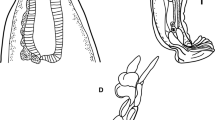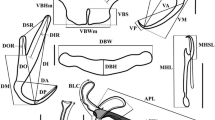Abstract
Introduction
Specimens of Rhinobatonchocotyle pacifica Oliva & Luque, 1995 (Hexabothriidae) were collected from the gill filaments of Pacific guitarfish, Pseudobatos planiceps (Garman, 1880) (Rhinopristiformes: Rhinobatidae), from off the coast of Chorrillos, Lima, Peru. Since the original description of R. pacifica was incomplete, we herein redescribe R. pacifica based on re-examination of the holotype, paratypes, and newly collected voucher specimens. Nucleotide sequences (18S, 28S) for R. pacifica are presented for the first time, and a phylogenetic analysis conducted.
Materials and Methods
Monogeneans were examined with light microscopy and partial sequences of 18S and 28S rDNA genes were obtained.
Results
The following taxonomically important morphological features are described: presence of seminal receptacle, spiniform papillae within oral cavity, haptoral sucker sclerites and anchors, hook surface striations, muscular pad associated with each haptoral sucker sclerite (except sclerite 1), muscular bulbs in appendix suckers, and oötype lacking longitudinal rows of large cells (oötype not côtelé). The genital complex is detailed. The diagnosis of Rhinobatonchocotyle is emended to include species with or without seminal receptacle. Representative nucleotide sequences of partial 18S and 28S rDNA genes of R. pacifica were obtained for the first time and used for reconstructing the phylogeny of Hexabothriidae.
Conclusion
The phylogenetic reconstruction confirmed the species within the Hexabothriidae.




Similar content being viewed by others
References
Miloslavich P, Klein E, Díaz JM, Hernández CE, Bigatti G, Campos L, Artigas F, Castillo J, Penchaszadeh PE, Neill PE, Carranza A, Retana MV, de Astarloa JMD, Lewis M, Yorio P, Piriz ML, Rodríguez D, Yoneshigue-Valentin Y, Gamboa L, Martin A (2011) Marine biodiversity in the Atlantic and Pacific coasts of South America: knowledge and gaps. PLoS ONE 6:e14631. https://doi.org/10.1371/journal.pone.0014631
Cornejo R, Vélez-Zuazo X, González-Pestana A, Kouri JC, Mucientes C (2015) An updated checklist of Chondrichthyes from the southeast Pacific off Peru. Check List 11:1–7. https://doi.org/10.15560/11.6.1809
Eiras JC, Velloso AL, Pereira J Jr (2016) Parasitos de Peixes Marinhos da América do Sul. Editora FURG, Rio Grande, p 441
Luque JL, Cruces C, Chero J, Paschoal F, Alves PV, Da Silva AC, Sánchez L, Iannacone J (2016) Checklist of metazoan parasites of fishes from Perú. Neotrop Helminthol 10:301–375
Chero JD, Cruces CL, Sáez G, Camargo ACA, Santos CP, Luque JL (2018) Hypanocotyle bullardi n. gen. n. sp. (Monogenea: Hexabothriidae) from gill of the diamond stingray Hypanus dipterurus (Jordan et Gilbert) (Myliobatiformes: Dasyatidae) in the Southeastern Pacific Ocean off Peru. Parasitol Int 67:425–430. https://doi.org/10.1016/j.parint.2018.03.010
Chero JD, Cruces CL, Sáez G, Luque JL (2018) A new genus and species of the Dasybatotreminae Bychowsky, 1957 (Monogenea: Monocotylidae), parasitic on Hypanus dipterurus (Jordan & Gilbert) (Myliobatiformes: Dasyatidae) in the Southeastern Pacific Ocean off Peru. Zootaxa 1:347–356. https://doi.org/10.11646/zootaxa.4527.3.4
Martínez R, Tantaleán M, Mondragón-Martínez A, Pulido E, Delgado A (2016) Nuevos reportes de monogeneos en peces marinos de la costa peruana. Peruv J Parasitol 24:8–14
Eschmeyer WN, Fricke R, Van der Laan R (eds) (2018) Catalog of fishes: genera, species, references. Available at www.calacademy.org, version 03/2018. Accessed March 2018
Humason GL (1979) Animal tissue techniques, 4th edn. W. H. Freeman and Company, San Francisco, p 661
Billings AN, Teltow GJ, Weaver SC, Walker DH (1998) Molecular characterization of a novel Rickettsia species from Ixodes scapularis in Texas. Emerg Infect Dis J 4:305–309. https://doi.org/10.3201/eid0402.980221
Hassouna N, Michot B, Bachellerie JP (1984) The complete nucleotide sequence of mouse 28 s rRNA gene. Implications for the eukaryotes. Nucleic Acids Res 12:3563–3583. https://doi.org/10.1093/nar/12.8.3563
Sinnappah ND, Lim LHS, Rohde K, Tinsley R, Combes C, Verneau O (2001) A paedomorphic parasite associated with a neotenic amphibian host: phylogenetic evidence suggests a revised systematic position for Sphyranuridae within anuran and turtle polystomatoineans. Mol Phylogenet Evol 18:189–201. https://doi.org/10.1006/mpev.2000.0877
Kumar S, Stecher G, Tamura K (2015) MEGA7: molecular evolutionary genetics analysis version 7.0. Molecular biology and evolution (submitted). (Publication PDF at http://www.kumarlab.net/publications)
Altschul SF, Gish W, Miller W, Myers EW, Lipman DJ (1990) Basic local alignment search tool. J Mol Biol 215:403–410. https://doi.org/10.1016/S0022-2836(05)80360-2
Thompson JD, Higgins DG, Gibson TJ (1994) CLUSTAL W: improving the sensitivity of progressive multiple sequence alignment through sequence weighting, position-specific gap penalties and weight matrix choice. Nucleic Acids Res 22:4673–4680. https://doi.org/10.1093/nar/22.22.4673
Felsenstein J (1981) Evolutionary trees from DNA sequences: a maximum likelihood approach. J Mol Evol 17:368–376. https://doi.org/10.1007/BF01734359
Boeger WA, Kritsky DC (1989) Phylogeny, coevolution, and revision of the Hexabothriidae Price, 1942 (Monogenea). Int J Parasitol 19:425–440. https://doi.org/10.1016/0020-7519(89)90099-4
Doran DJ (1953) New monogenetic trematodes from the shovelnose guitar fish, Rhinobatos productus (Ayres). J Parasitol 39:145–151. https://doi.org/10.2307/3274109
Oliva ME, Luque JL (1995) Rhinobatonchocotyle pacifica n. sp. (Cercomeromorphae: Monogenea: Hexabothriidae) parasite of Rhinobatos planiceps (Rhinobatidae) from Northern Chile. Revista de Biología Marina 30:1–5
Pollerspöck J, Straube N (2015) Bibliography database of living/fossil sharks, rays and chimaeras (Chondrichthyes: Elasmobranchii, Holocephali): host-parasite list and parasite-host list. World Wide Web electronic publication. www.shark-references.com, version (04/2015). https://doi.org/10.13140/RG.2.1.3636.6887
Bullard SA, Dippenaar SM (2003) Branchotenthes robinoverstreeti n. gen. and n. sp. (Monogenea: Hexabothiidae) from gill filaments of the bowmouth guitarfish, Rhina ancylostoma (Rhynchobatidae), in the Indian Ocean. J. Parasitol 89:595–601. https://doi.org/10.1645/0022-3395(2003)089%5b0595:BRNGAN%5d2.0.CO;2
Patella R, Bullard SA (2013) Hexabothriids of devil rays (Mobulidae): new genus and species from gill of Mobula hypostoma in the Northern Gulf of Mexico and redescription of a congener from Mobula rochebrunei in the Eastern Atlantic Ocean. J Parasitol 99:856–867. https://doi.org/10.1645/12-153.1
Watson DE, Thorson TB (1976) Helminths from elasmobranchs in central American fresh waters. In: Thorson TB (ed) Investigations of the Ichthyofauna of Nicaraguan Lakes. School of Life Sciences, University of Nebraska-Lincoln, Lincoln, pp 629–640
Ogawa K (1991) Ectoparasites of sawfish, Pristis microdon, caught in freshwaters of Australia and Papua New Guinea. In: Shimizu M, Taniuchi T (eds) Studies on Elasmobranchs collected from seven river systems in Northern Australia and Papua New Guinea, vol 3. Nature culture. University of Tokyo, Tokyo, pp 91–102
Quiterio-Rendon G, Monks S, Pulido-Flores G (2018) Neonchocotyle violantei n. sp. (Monogenea, Hexabothriidae) from Pseudobatos lentiginosus (Rhinopristiformes, Rhinobatidae) of Yucatán, Gulf of Mexico. Braz J Vet Parasitol 27:33–41. https://doi.org/10.1590/S1984-29612017077
Tantaleán M, Morales E, Hermes E (1998) Una nueva especie y nuevo registro de monogeneos parásitos en peces marinos del Perú. Parasitología al día 22:41–44. https://doi.org/10.4067/S0716-07201998000100008
Acknowledgements
To Anna Phillips (USNM) for allowing us access to specimens under her care. We also thank Griselda Pulido-Flores for providing us with valuable literature on hexabothriids. The authors are grateful to the following people who helped to the collection of fishes in Peru: Ivette Cuellar, Eva G. Huancachoque and Cynthia E. Rodríguez, all from the National University Federico Villarreal (UNFV). José L. Luque and Cláudia P. Santos were supported by a Researcher fellowship from the Conselho Nacional de Desenvolvimento Científico e Tecnológico, Brazil (CNPq). Jhon D. Chero and Celso L. Cruces were supported by a student fellowship from the Coordenação de Aperfeiçoamento de Pessoal do Ensino Superior, Brazil (CAPES)—Finance Code 001.
Author information
Authors and Affiliations
Corresponding author
Additional information
Publisher's Note
Springer Nature remains neutral with regard to jurisdictional claims in published maps and institutional affiliations.
Rights and permissions
About this article
Cite this article
Chero, J.D., Cruces, C.L., Sáez, G. et al. Redescription and First Nucleotide Sequences of Rhinobatonchocotyle pacifica Oliva & Luque, 1995 (Monogenea: Hexabothriidae), a Parasite of Pseudobatos planiceps (Garman, 1880) (Rhinopristiformes: Rhinobatidae) from Peru. Acta Parasit. 64, 797–806 (2019). https://doi.org/10.2478/s11686-019-00101-4
Received:
Accepted:
Published:
Issue Date:
DOI: https://doi.org/10.2478/s11686-019-00101-4




